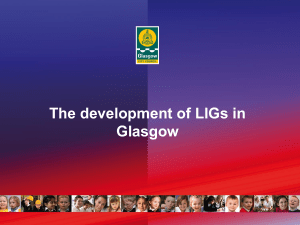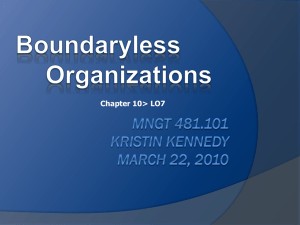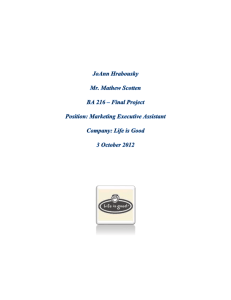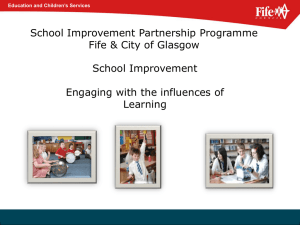advertisement
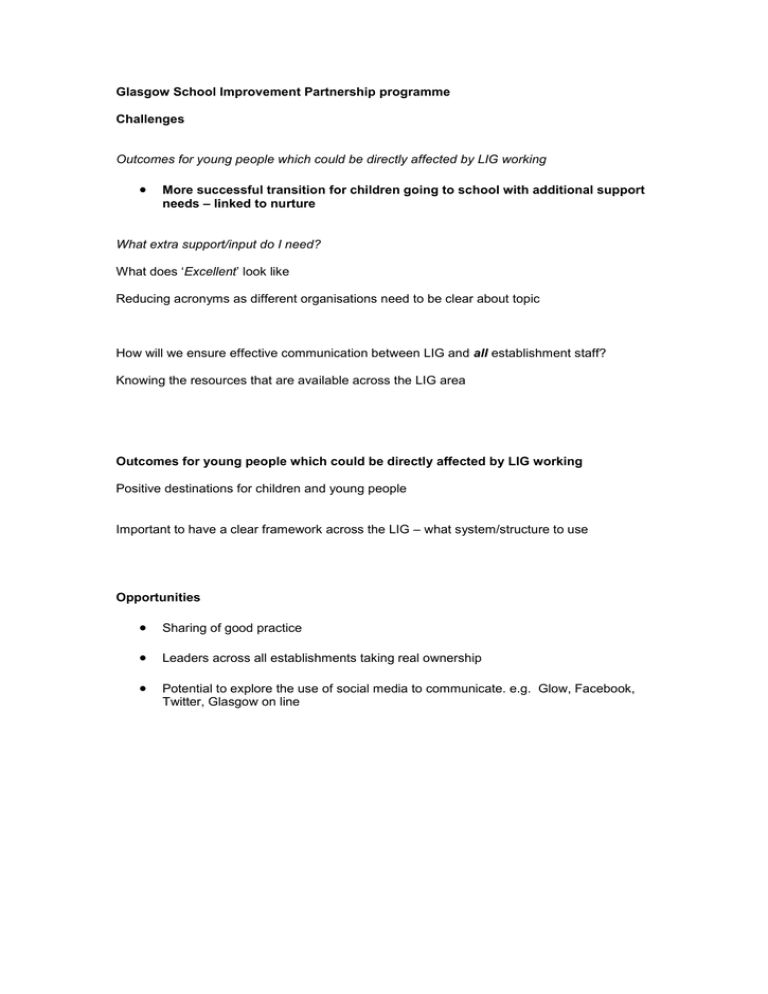
Glasgow School Improvement Partnership programme Challenges Outcomes for young people which could be directly affected by LIG working More successful transition for children going to school with additional support needs – linked to nurture What extra support/input do I need? What does ‘Excellent’ look like Reducing acronyms as different organisations need to be clear about topic How will we ensure effective communication between LIG and all establishment staff? Knowing the resources that are available across the LIG area Outcomes for young people which could be directly affected by LIG working Positive destinations for children and young people Important to have a clear framework across the LIG – what system/structure to use Opportunities Sharing of good practice Leaders across all establishments taking real ownership Potential to explore the use of social media to communicate. e.g. Glow, Facebook, Twitter, Glasgow on line Existing Good Practice across all LIG establishments Effective Area Meetings Peer Trios working effectively across the area Formal & Informal networking working well Learning Community Meetings Open Doors opportunities offered CPD opportunities for all staff Effective QIO Support and challenge for individual Curricular Areas Strong Primary/Secondary Curricular Links Sharing Good Practice Transition Planning/transition groups Networking Meetings (ASN) AHDS Opportunities Peer Shadowing Head Teacher Trios SQR Monitoring Personnel EPR Validated Self-evaluation discussions School Improvement Plans Linking with partnership groups e.g. G15/Glasgow Life Parent council involvement at school level Strong involvement of pupil groups Links with Fife Council Informal networking opportunities between heads Trios HMIE & Care Inspectorate results External accreditation awards including SQA results LC Moderation exercises High focus on pupil voice Whole school themes – monitoring of learning and teaching Quality reviews of nurture groups Positive leaver destinations VSE and thematic quality review results Screening of phonological awareness – early years Strengths and difficulties questionnaires Psychological services and LC practice level agreement (PLA) in place Staged Intervention embedded Potential developments identified across all LIG establishments Opportunities to increase partnership working with the 3rd sector Identify ‘gaps’ in wider achievement & use partners to help offer opportunities Opportunities for increased working with Education Scotland Improved links with the Glasgow Science Centre International Education Museum Services Active Schools Co-ordinators WOSDEC (West of Scotland Development Education Centre) Interrupted Learners Service Glasgow Life Community & Business Support Land & Environmental Services ARC Leaders of Learning Potential to involve young people more in making decisions Potential to strategically lead from LIG level Use AA (associate assessor) staff within the Authority to share best practice in self-evaluation Glasgow Online/GLOW/GOLD/ Education Scotland website Volunteer Tutors Organisation Outdoor Learning Organisations Utilise creative models of reporting to parents Outreach from ASN Establishments Sharing resources - Good practice - Staff Sharing standards and reports EPR Care Inspectorate Partnerships Working with QIOs to make improvements and support QIOs Extra staff resources to allow staff off floor Links with health visitor External agencies Third Sector Parents, pupils, social work Glasgow Life Validated self-evaluation Database of what is available from e.g. Glasgow Life Community Planning LIG Education Scotland National Network LIG Networking forums - Middle managers More flexible working time agreements to support partnerships Staff exchange Mechanisms for involving partner agencies Trios - More focused - Intelligence led - Systematic - matched Effective use of technology to support meetings and networking Potential for more Thematic Reviews Should be a wider sharing of RIFs Directorate sampling of school performance The LIG to take responsibility to audit performance Potentially more work required across LIG establishments How to use data responsibility and sensitively (clear protocols) What are the overall responsibilities of the LIG? How do we help all staff understand what underpins the LIGs Involvement of partners in establishment self-evaluation Parental Input to transition process e.g. Pre & post questionnaire HMIE illustration on ‘Excellent’ practice to be more informative Stronger pupil voice in establishment self-evaluation processes Improved benchmarking Create more opportunities for peer observation to build confidence in individual teachers Progression with core and challenge through a 3-18 curriculum Creation of opportunities to see ‘Excellent’ practice and create more systematic ways of sharing good practice generally. Trust issues between staff around transitions Extend – HT trios to link to other aspects of school life e.g. school twinning within Glasgow Opportunities to visit other classrooms & other schools Moderation (beyond set pieces of work, looking at ethos) Operational planning structures → streamlining Opportunities to work across sector → requires more thought Involvement of middle tier (personnel) – principal teachers (networking) Better system for identifying schools with shared priorities and practice Systems for mapping evidence of partners M Agency Peer assessment within and outwith establishments Improving our playrooms for team leaders (& CDO’s) CPD Training for all staff More sector focussed work/moderation Staff working in another establishment for a period Effective communication Agenda setting for trios Training for Trios Expansion of Trio Trios across areas of city Health Rep on LIG Evaluation of Trios Database of good practice Confidence in one is professional judgement Mix up trios Training for learning rounds Joints projects between schools Awareness raising within LIG of what our partners can actually offer – range of things that may currently be known ‘locally’ but have scope to be rolled out across LIG. Importance of ‘ensuring’ the children and young people are fully involved in the process – need to be involved and engaged (ownership of their learning) Establishments need to identify the key area/areas that require further support from LIG. The time period to work on these should extend over one school year if necessary. There will potentially be the need to ring fence time in working time agreements and at in-set days to drive forward LIG developments Next Steps Further discussion is needed on how all staff can be engaged in the process. There needs to be agreed transparency regarding selection of personnel for the steering group and how long staff should serve There needs to be a realistic pace of change for developments Decision on Core group/extended groups to support agreed tasks Need to ensure that good practice is shared across the city so that those not included in LIG priorities also have support from elsewhere. Nominations for steering group membership should come from within the LIG establishments themselves and not be ‘imposed’ from centre Existing structures e.g. Heads meetings/ area meetings could be used for LIG discussion and communication Need clear plan for LIG – priorities would inform ‘make up’ at the group Potentially establish a representative teacher group – providing info Priorities need to be shared with all involved Widen LC meetings to include partnership groups Consider establishing a LIG “web page” or e-bulletin ‘test of change’/’implementation science’ approaches Important that we don’t create an additional tier of meetings
